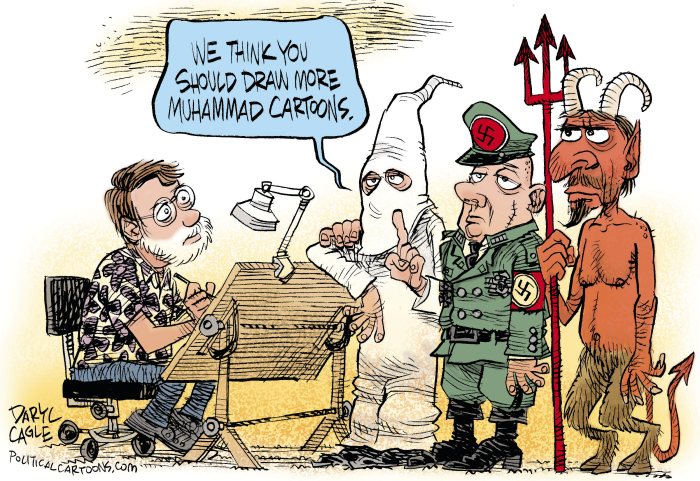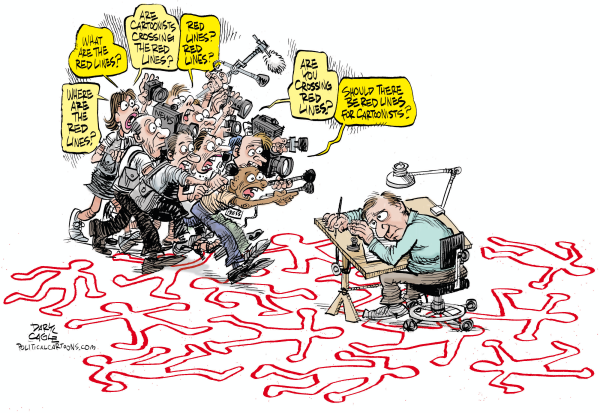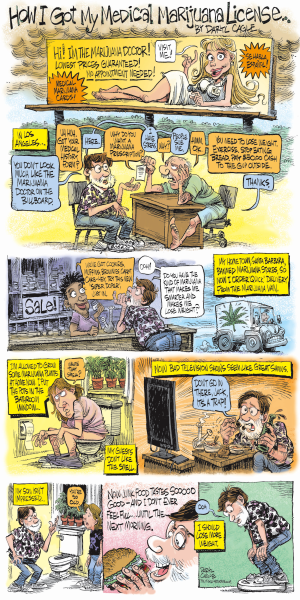
A column in Sunday’s Los Angeles Times starts off like this:
“POPE JOHN XXIII, or ‘Good Pope John,’ remains one of the most beloved figures in recent Catholic history. Among treasured memories of this kindly, roly-poly pope, perhaps none looms larger than the evening of Oct. 11, 1962, when he told a vast crowd on a moonlit night in St. Peter’s Square, ‘Go home tonight and give your children a kiss, and tell them that this kiss comes from the pope.’ When German Cardinal Joseph Ratzinger, the Vatican’s stern doctrinal enforcer, was elected as Benedict XVI in April, an editorial cartoon in an Italian paper showed him looking at a similar crowd and saying, ‘Go home tonight and give your children a spanking, and tell them that this spanking comes from the pope.’
“In a nutshell, the cartoon captured many people’s expectations of Benedict XVI: a hard-line taskmaster who would bring liberals and dissenters in Roman Catholicism to heel.”
Speakers and columnists, like this one, often quote cartoons but seldom mention the name of the cartoonist. With this writer, one fourth of his column came from an uncredited cartoonist. (I think it is fitting that one fourth of my own column starts off with a quote from a writer whom I have chosen not to name.) Writers are almost always named when they are quoted, but cartoons seem to be mere anecdotes that deserve no attribution beyond, “I saw this cartoon …”
An unnamed op-ed page editor at the Los Angeles Times told me that he doesn’t like political cartoons because they tend to “overpower the words that surround them.” He went on to tell me that his two favorite cartoonists are Tom Toles and Ted Rall, two cartoonists with rudimentary drawing styles who put lots of words into their cartoons; this editor liked these cartoonists because they were “more like writers than artists.”
There seems to be a natural friction between the “picture people” and the “word people” who are troubled by those powerful pictures. A famously unnamed editor at The New York Times is quoted as saying, “We would never hire an editorial cartoonist at the Times, because we would never give so much power to one man.” Another unnamed New York Times editor is quoted as saying, “We don’t like editorial cartoons at the Times because you can’t edit a cartoon like you can edit words.”
Editors see cartoonists as “bomb throwers,” because cartoonists enjoy a different set of journalist ethics than writers. Cartoonists can put any words into the mouth of a public figure, whether those words were actual quotes or not. Cartoons make readers angry. A strong political cartoon generates much more mail from readers than the strongest words. Most editors are timid and want to avoid controversy; they choose to run syndicated cartoons that are unobjectionable gags about current topics. Cartoonists call this “Newsweekification” after the inoffensive, bland and opinionless – but funny – political cartoons that Newsweek magazine chooses to reprint each week, further trivializing political cartoons.
The power and effectiveness of political cartoons cause more and more newspapers to avoid cartoons. There are half as many editorial cartoonist jobs as there were 75 years ago. Of the biggest newspapers in America – The Wall Street Journal, USA Today, The New York Times, the New York Daily News, the Chicago Tribune – none have political cartoonists on staff.
The newspaper industry often complains about a dwindling and aging readership as younger readers prefer to get their news through other media. The old-line “word people” lament that youngsters nowadays get their news from Jon Stewart on “The Daily Show.” In fact, most young people get their news from political cartoons. Every state in the United States has middle and high school students interpret an editorial cartoon as part of state-mandated testing. Teachers who must “teach to the test” include political cartoons in their classes. Students learn their current events through political cartoons and, ironically, most of the students see newspaper political cartoons on the Internet rather than on paper (visit www.cagle.com). The “word people” who run newspapers have “Newspapers In Education” programs to try to develop a younger readership, but when a stack of newspapers is dropped on a teacher’s doorstep once a week, there is usually only one political cartoon on the editorial page – not very useful to a teacher who only needs the newspaper to teach about editorial cartoons.
Perhaps in the future we’ll see this turn around, and see more columns like this one, where cartoonists’ names are mentioned and writers’ names are not; when that happens, I expect traditional newspapers will have long gone extinct. Just as the cockroach will continue to roam the Earth long after mankind has disappeared, political cartoonists will still be crawling out from dark corners long after the “word people” have killed off newspapers.
Daryl Cagle is a political cartoonist and blogger for MSNBC.com. He is a past president of the National Cartoonists Society and his cartoons are syndicated to more than 800 newspapers, including the paper you are reading. His books “The BIG Book of Bush Cartoons” and “The Best Political Cartoons of the Year, 2005 Edition,” are available in bookstores now.















